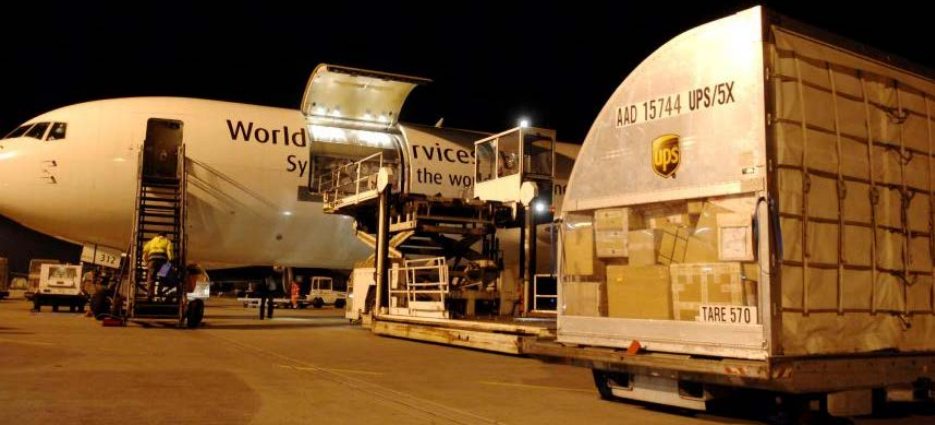Climate and Weather Data Carry Weight in Transportation Sector
 [FedEx Airbus landing. From pixabay.com]
[FedEx Airbus landing. From pixabay.com]
When delayed deliveries can cause many cascading repercussions—from business interruptions to diminished consumer confidence—information becomes vital. “Someone awaiting a package in Bangkok doesn’t care if it snowed in Louisville, Kentucky. They want their stuff,” says Randy Baker, UPS meteorologist, as cited in a new report about the value of NCEI’s data.
Express Couriers
In the express courier industry, which expedites time-sensitive documents, small parcels, and high-value items, historical records are used to reduce weather risks and optimize performance. For instance, data from our Integrated Surface Database (ISD) have contributed to the International Station Meteorological Climate Summary (ISMCS). ISMCS, referred to as the “climate disk,” contains detailed historical summaries of daily, hourly, and monthly reports of air temperature, precipitation, wind, clouds, pressure, and various other elements from 640 primary weather observation sites and more than 5,800 secondary sites worldwide.
 [Loading of UPS cargo plane. Source: Spiegel Online]
Companies that make up a large portion of the $82 billion express courier industry depend on the ISMCS for many applications, such as:
[Loading of UPS cargo plane. Source: Spiegel Online]
Companies that make up a large portion of the $82 billion express courier industry depend on the ISMCS for many applications, such as:
- Landing visibility minimums
- Strategic planning of airport locations
- Deicing decisions
- Transport of temperature-sensitive goods
- Weather model verification
 [Airplane de-icing. Source: UPS]
[Airplane de-icing. Source: UPS]
Railways
For railroads, a major provider of long-haul freight, weather and climate data reduce vulnerabilities to rail infrastructure when changes in temperature and weather conditions occur.
The $60 billion railway industry transports coal, raw metal ores, agricultural commodities, and consumer goods while relying on our products analyzed by a third-party weather service. Our Local Climatological Data (LCD), Integrated Surface Daily Database (ISD), and Global Historical Climatology Network, Daily (GHCN-D) provide a foundation for freight management. The data help several ways: to support historical event analysis to inform risk management, to provide weather-related evidence to support legal claims, and to enhance network optimization. On the ground, decision makers can use the data to avoid disruptions in service. Tornados and high winds can topple rail cars, and avalanches in mountainous regions can block tracks. Landslides, mudslides, erosion, and floods can damage tracks, culverts, and bridges. Cold temperatures can cause broken rails, toppling of rock slopes, frost heaves, and icing of switches. Additionally, high temperatures and direct exposure to sunlight can cause sun kinks.
For instance, during high heat, railway heat tolerance thresholds can be analyzed and compared to current conditions before breaches happen. Preemptively, train speeds can be decreased, loads can be reduced during peak heat, and railway workers can be dispatched to search for visible signs of track damage.
On the ground, decision makers can use the data to avoid disruptions in service. Tornados and high winds can topple rail cars, and avalanches in mountainous regions can block tracks. Landslides, mudslides, erosion, and floods can damage tracks, culverts, and bridges. Cold temperatures can cause broken rails, toppling of rock slopes, frost heaves, and icing of switches. Additionally, high temperatures and direct exposure to sunlight can cause sun kinks.
For instance, during high heat, railway heat tolerance thresholds can be analyzed and compared to current conditions before breaches happen. Preemptively, train speeds can be decreased, loads can be reduced during peak heat, and railway workers can be dispatched to search for visible signs of track damage.
 [Railway Buckling Source: U.S DOT Volpe Center]
[Railway Buckling Source: U.S DOT Volpe Center]
Broader Impact of NCEI Data
Managing weather risks and improving services with appropriate data strengthen other segments of the U.S. economy. With tens of millions of packages due for delivery each day, a single delay causes ripple effects for many businesses and citizens.
For bulk goods, the U.S. freight rail network transports five million tons of cargo on a daily basis. As a system interconnected with many other sectors, such as energy, retail, and agriculture, a disruption in transport or logistics can introduce gaps in the broader supply chain and the economy. Demand for weather and climate data take on greater importance to support commerce in this and other sectors. Edited for WeatherNation by Meteorologist Mace Michaels